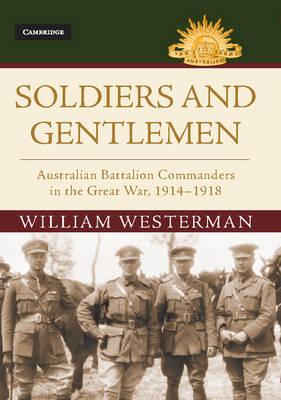Dr. Westerman is currently a researcher and adjunct lecturer at UNSW Canberra. This is the first book to examine the background, role and conduct of Australian commanding officers during the First World War. Westerman explores the stories of these vitally important but often forgotten key figures. At its height, the AIF had 60 infantry battalions across 5 divisions deployed on the Western Front. 211 Lieutenant Colonels commanded these battalions at various stages of the war.

Hardback 348 pp RRP: $59.95
For those of us who have had the privilege to command a battalion or similar sized unit, this book provides an insight into the roles and pressures on commanding officers and the minutiae of battalion life between 1915 and 1918. Westerman chronicles the transformation of the COs and their AIF battalions from the enthusiastic amateurs who landed at Gallipoli to the highly-trained and efficient units that dominated the battlefield in 19
The book is divided into seven chapters with a chronological sequence from the raising of the AIF in 1914, the Gallipoli campaign and the Western Front battles of 1916 and 1917, culminating in the victories of 1918. These accounts are supplemented by tables and photographs within the body of the book as well as several comprehensive appendices including the names of COs of each AIF battalion from 1915 – 1918, their origins, fates, religion, places of birth (only one CO came from Western Australia) and occupations (32% professional, 23% business, 11% agricultural). The final appendix outlines the detailed organisation table of an AIF battalion in 1918.
Westerman’s book commences with the formation of the AIF in 1914, the training in Egypt and the Gallipoli campaign. He describes the process whereby the brigade commanders selected and appointed their battalion commanders – not necessarily the best decisions as the landing at Gallipoli exposed. Some COs were removed for “medical reasons” and sent back to Australia or transferred to administrative roles. Only four of the sixteen COs who landed at Gallipoli lasted in command until the start of 1916.
The transfer to the Western Front saw the AIF divisions merged into the British Expeditionary Force, becoming part of a huge command, logistic and training system. Westerman described and discussed the various responsibilities of the CO to their men including leadership, administration, morale, and discipline. He discusses the appointment, training and removal of COs and the positive influence of the BEF senior officers’ course that prepared selected majors for command appointments.
I found the sections that concentrated on the CO’s responsibility for tactical operations most interesting – organisation, training, trench fighting, communications, fire support and the gradual introduction of combined arms warfare.
Soldiers and Gentlemen fills an important place in our military history. “Of all the men who can make or mar an Australian force, the unit commander is the most important” C E W Bean 1933.
Reviewed by John Coulson, May 2017, for RUSIV
Contact Royal United Services Institute about this article.






